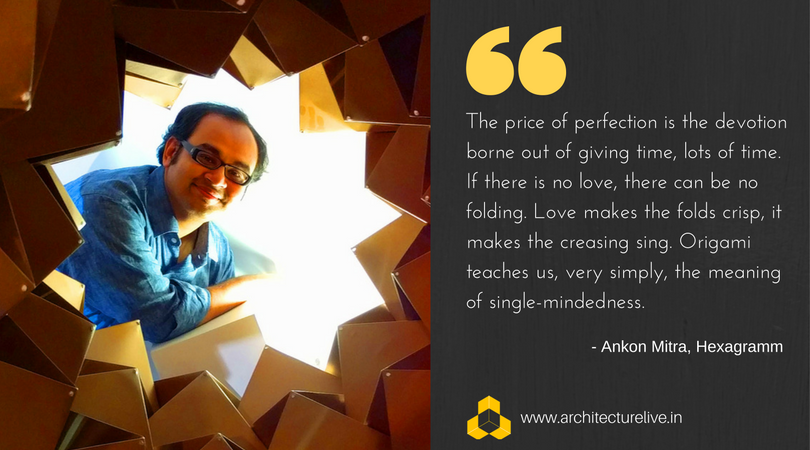We got in touch with Ankon Mitra – co-founder of Hexagramm – to learn about his research and artistic exploration in the field of Oritecture, and what it entails.
AL: What is Oritecture? How does it relate itself to architecture?
AM: Oritecture is Origami + Architecture; it is the infusion of the ideas, philosophy and the expression of folding into architecture and design. From the formation of mountains (the Himalayas are young fold mountains) to the making of the coastlines of continents, folding is the fundamental technique employed by nature to create a vast variety of shapes and forms.
Oritecture as an initiative is only a constant reminder to myself to explore and unearth this fundamental phenomenan, and emulate these guiding principles in not only architecture, but all things that I create.
AL: What inspired you to pursue Oritecture? Can you tell us about how you started?
AM: There were two catalysts:
1. Our Studio was asked to design a private airport in Shimoga, Karnataka – and we discovered during my explorations in roof design that folding a flat sheet in two directions makes it extremely strong, structurally. Structural optimization using Origami (to create rigid folded-sheet forms) can save material and create extremely large, ultra-lightweight, column-free spans. Additionally, Origami sheet forms are visually and aesthetically stunning. The airport was never built, but the project started a life-long love affair with Origami.
2. I met an amazing gardener at the Kew Gardens in the U.K. I have been fascinated by the plant world since my early school days; the magic of trees – their foliage, their various processes and the almost machine-like precision with which these are carried out to achieve optimum results –are of abiding interest to me, and central to my work and research.
While at Kew Gardens, the gardener educated me about the intrinsic use of folding processes in leaves and flowers as a growth and energy-saving strategy by plants. I discovered that folding is used by the plant kingdom as a fundamental technique, as an optimization algorithm for myriad tasks. This tracked back to my intense interest in Biomimicry – if the natural world is using a technique repeatedly and for varied purposes – and at several scales – it obviously works, and we need to study it carefully and learn the hows and whys of it.
AL: Does Oritecture have a place in the mainstream, beyond its cosmetic and/or decorative applicability? Can you tell us about a few cases in which it contributed to the form or function of a building?
AM: I can give four examples:
1. Spanning Large Spaces, Economically: In Architecture, Origami goes structurally by the name of ‘folded plates’. A sheet material (usually steel) is folded in a basic tessellation pattern and this immediately gives it immense strength. This is a very old idea and the architect Max Abramovitz used it in a fantastic manner by using pre-stressed concrete to create a clear dome span of 400ft. diameter, tapering to a thickness of a mere 3.5 inches.
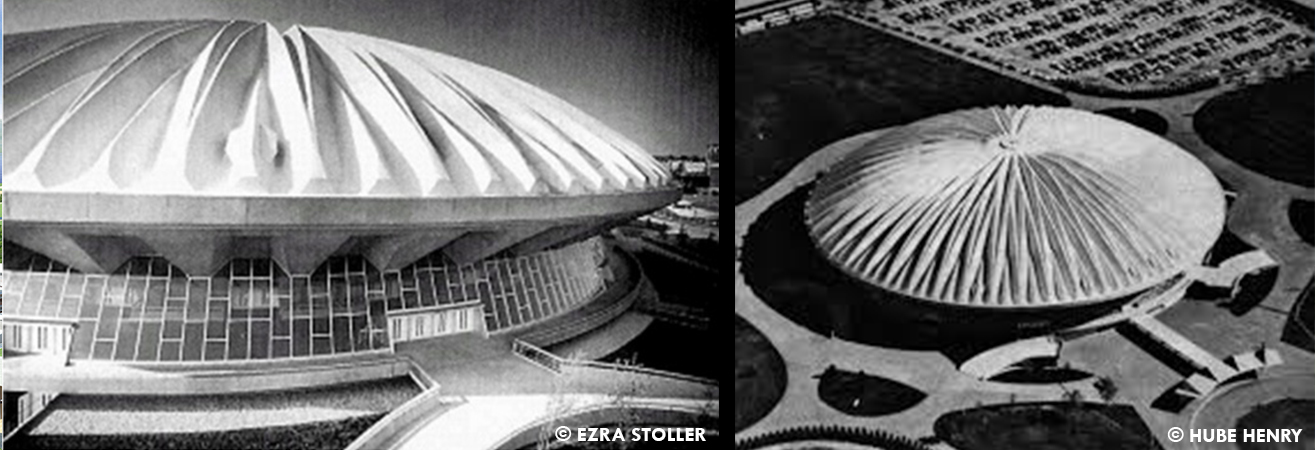
Domes are pure compression structures, ideally speaking, and end up being massively thick to allow for this, and therefore cannot have very large spans due to self-weight. Abramovitz pushed RCC technology to its limits by not only using pre-stressed concrete technology, but by adding folding logic into this mix. Built in 1963, this famous ‘folded’ dome is the indoor stadium of the University of Illinois at Urbana-Champaign in the U.S.
2. As a Sun Shade Strategy: AEDAS Architects have fused the idea of a traditional Mashrabiya (Jaali/Fretwork) shading device with the idea of Origami to come up with a dynamic façade on the Al-Bahar Towers in Abu Dhabi, U.A.E. Based on the Ron Resch triangular waterbomb grid pattern, the Origami tessellation grid is connected to a main-frame computer which allows control of the individual panels to create varying amounts of daylight ingress and shading for different times of the day.
This dynamic façade has been placed on the South, South-East, South-West and West facades of the towers, allowing diffused light from the North and North-West, and early morning light from the East to directly enter the building. (The panels can be seen in action HERE.)
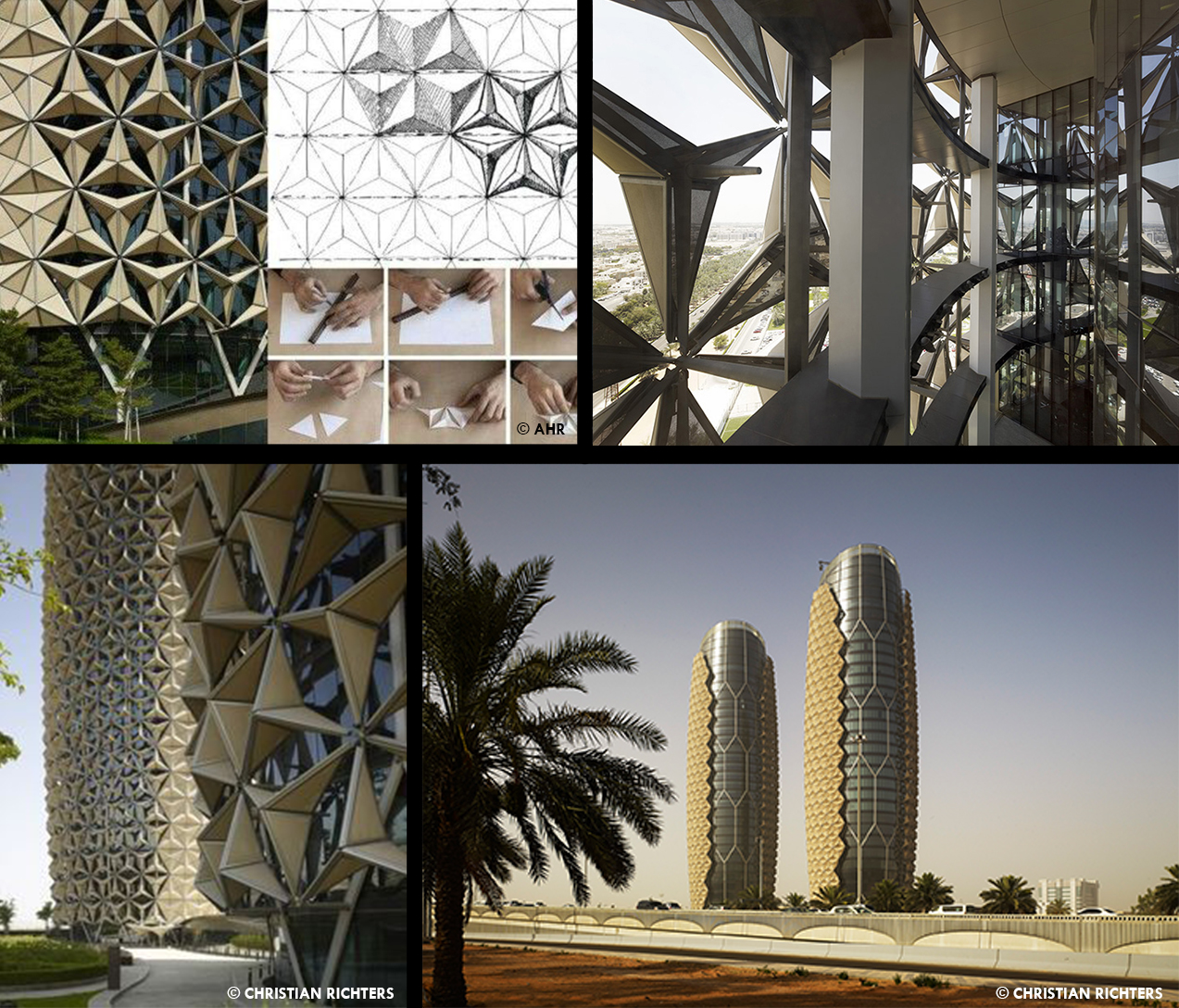
3. Extending Usable Shaded Space: An umbrella is one of the finest and simplest examples of useful dynamic Origami, even in an Architectural context. At the Al-Nawabi Mosque in Medina, over 150 giant umbrellas made of Teflon and stainless steel expand the usable shaded space in the Piazza by over 1,00,000sq.m – especially during the hot Ramadan months, when maximum visitors fill the mosque courtyards to the brim. The Umbrellas help to bring down temperatures from an unbearable 52 degrees Celsius to less than 39 degrees.
The fabric of the umbrellas (and the underlying SS wire-grid) is based on the Origami radial diamond pattern. The Umbrellas are controlled by a central computerized command system and can remain closed in the evenings and mornings if not required. The Umbrellas were first conceptualized and executed at the Sayyidna Al-Husseyn Mosque in Cairo by the architect Mahmoud Bodo Rasch. (The automation of the umbrellas can be seen HERE and HERE)

4. Deployable Shelters in Emergencies and Disaster Mitigation: The earliest known examples of such easily deployable and quickly constructed shelters based on Origami principles are credited to a team consisting of architects Sim Van der Ryn and Sanford Hirhsen, and Canadian manufacturer Herb Yates between 1964 and 1974. The perfected design was called the Casa Accordeana and several hundreds of them were constructed in the USA as transit housing for Mexican migrant workers in the California farmlands. Each house measuring 16 feet X 24 feet in plan consisted essentially of a plywood floor, and the Origami ‘tent’ on top was folded from ‘Foam-Core’ – two layers of heavy, water-resistant paper sandwiching a layer of Styrofoam.
This lightweight material gained immense strength by the folding process, especially the V-pleats at the crucial junctions. The roofs were anchored to the plywood platform with specially designed metal cleats and angles. The roofs could be folded up, packed and transported in trucks to the temporary housing sites and deployed in half a day, including the platforms which formed the floor. Now, many more of such Origami-based designs have been refined and are being used by the US Armed Forces to set up camps swiftly in remote areas.
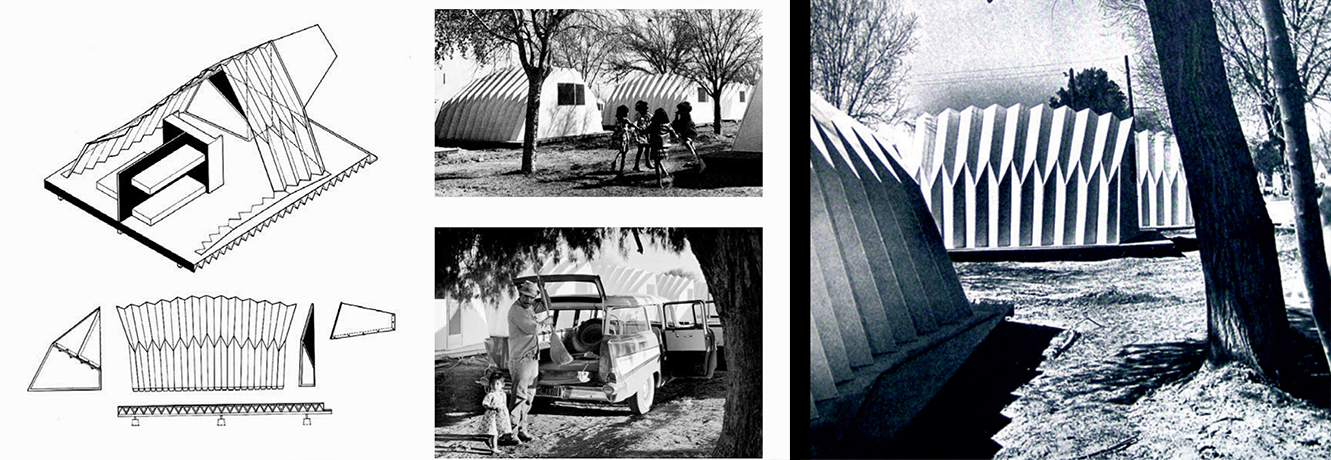
AL: It appears that Oritecture requires immense patience and persistence. How do you find it for yourself?
AM: The process is very immersive and meditative, like the chanting of a mantra or counting prayer beads. Once the creasing and folding steps are understood – especially in a repetitive pattern – the act can be trance-like. I have sometimes experienced this when deeply engrossed in the act of folding; the conscience remains mindful only of the material in the hand and the process to be followed in pleating it. Sometimes, the fingers get so used to the interval distances by which the creases appear, it is possible to close one’s eyes and just let the fingers ‘see’ and continue working.
Folding is a beautiful method to develop patience. Being such an easy medium to work with, paper can be extremely frustrating, because it takes very little for paper to get crushed, wrinkled, soggy and/or dirty. One wrong crease or fold, and it will never go away, even the memory of it – because we have broken the strands of the paper at the micro-structure level. Imperfection in paper cannot be hidden, stitched-away, painted or welded and grinded clean.
The price of perfection is the devotion borne out of giving time, lots of time. If there is no love, there can be no folding. Love makes the folds crisp, it makes the creasing sing. Origami teaches us, very simply, the meaning of single-mindedness.
AL: What advice would you give to students and young architects?
AM: I do not feel I have the qualifications or the calibre to give advice to anyone. However, about my technique, I would say – I have experienced that it is possible to fold all things. Folding is the technique – the medium can be anything. I have folded hundreds of types of paper, cardboard, polypropylene, acetate, leather, silk, sheet aluminium, sheet brass, sheet copper, wood veneer, dried leaves, molten chocolate . I have even folded sheet concrete and clay. It is great fun to fold wet sheets of clay. The experience is magical.
I am yet to fold molten glass, and a hundred other materials. I have also heard of stone paper, but am yet to get my hands on it. I will keep folding. From these experiences – where materials teach me about what they are and where they come from, what they will allow me to do with them and what they will not – I can only say, it is possible to learn something new every day. It is also desirable that learning should never stop. The more we learn, the more we realize how little we actually know, and this brings humility. Humility is essential for curiosity and further learning.
I do not meet enough young people anymore who like to use their hands and fingers for things other than keyboards and touch-pads. There’s a book called ‘The Case for Working with Your Hands’ by Matthew Crawford, and it is highly recommended for all young people.
The best kind of learning comes by doing, mucking about, and getting one’s hands dirty.
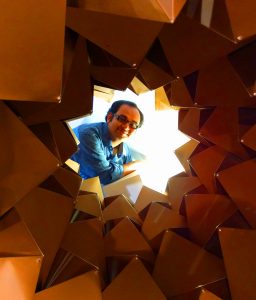 Ankon is an architect by training with a keen interest in the geometry and mathematics of plants, trees and flowers. A Gold-Medallist from the School of Planning and Architecture (S.P.A), New Delhi, and having pursued his Masters Degree from The Bartlett, University College London, he is Design Director (Landscape), at Hexagramm Design Pvt. Ltd. , working on resorts, farmhouses, hotels and residences of various sizes and imaginations. As part of his Oritecture initiative, he has conducted scores of workshops, designed interiors and sculptures for popular restaurant franchises, given a TEDx talk on the topic and hosted two solo art shows. He has also co-authored ‘Questioning Architecture’ with Gita Balkrishnan.
Ankon is an architect by training with a keen interest in the geometry and mathematics of plants, trees and flowers. A Gold-Medallist from the School of Planning and Architecture (S.P.A), New Delhi, and having pursued his Masters Degree from The Bartlett, University College London, he is Design Director (Landscape), at Hexagramm Design Pvt. Ltd. , working on resorts, farmhouses, hotels and residences of various sizes and imaginations. As part of his Oritecture initiative, he has conducted scores of workshops, designed interiors and sculptures for popular restaurant franchises, given a TEDx talk on the topic and hosted two solo art shows. He has also co-authored ‘Questioning Architecture’ with Gita Balkrishnan.
Coneect with Ankon Mitra on
Facebook: https://www.facebook.com/oritecture/
Instagram: https://www.instagram.com/ankonmitra/

